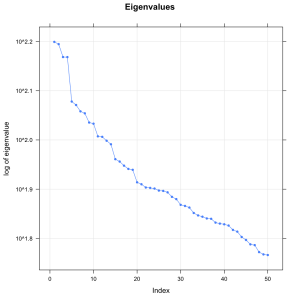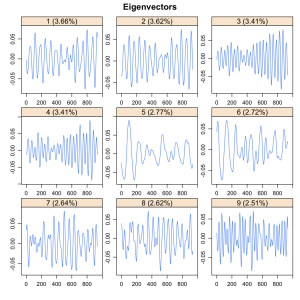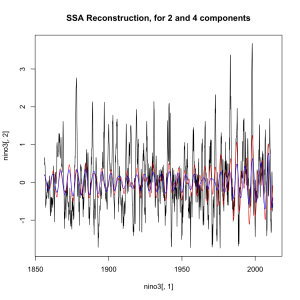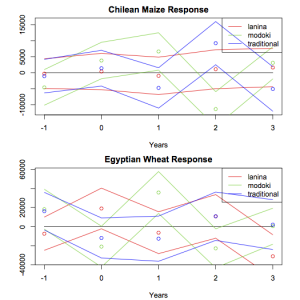NINO 3 is a measure of El Niño/La Niña (ENSO) intensity. It’s often said that ENSO has a period of 3-7 years. Why is it so hard to identify a single period? This is a job for SSA!

The scree plot shows that there are a ton of significant eigenvectors– this is a very complicated signal– but I want to focus on the first four, which are a shade more significant than the rest. They come in two pairs, which for SSA means that they represent two sinusoids. Here are the eigenvectors.

How well do these two capture the ENSO signal?

Not great, but it gets most of the ups and downs. Just not the peaks.
So what are the periods of these two? The first two are at 5.8 years, and the second two at 3.5 years. To note: those are relatively prime, so the two frequencies are always going to be going in and out of sync. So it’s not so much that ENSO has a clear frequency (it doesn’t), nor that that frequency is 3-7 years (because what would that mean anyway). It has two main frequencies, like a dial tone.
Science is constantly changing– we’re generating new data and developing new models faster than we can understand how they should all fit together.
My tool, the Distributed Meta-Analysis System, is ready to go, and I want to write more about it. But I also want to point people to two other interesting projects that seem to be trying to make science work better:
The Open Science Framework is trying to get people to make their data and papers and science, in general, available for all.
Curate Science is trying to solve the replication problem, encourage people to post their replication results and identifying needs.
For me, this is also about what might be called “Evolutionary Modeling”: modeling as a social and ongoing endeavor, involving many groups and combining their results in institutional ways. Science 2.0 is coming.
El Nino and La Nina affects crops in a lot of different ways. I’ve been looking at the response of agricultural yields over time to an ENSO event, where, depending on the dynamics of the social-natural system, impacts could persist for years after the impact or even emerge before the impact.
Here’s what country-wide production look like, in this impulse response framework. Neither Chile nor Egypt show a response to La Nina, but they both have strong responses (which appear to oscillate) to Modoki El Ninos.

The map below shows areas where Maize is grown (anywhere but black). Areas in white show no significant response from ENSO. Colored areas deviate from grey in three bands: red for a response to traditional El Ninos, green for a response to Modoki El Ninos, and blue for La Ninas.

Sustainability, Engineering, and Philosophy




